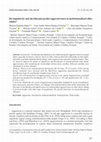Papers by Fernanda Daniel
Revista Portuguesa de Investigação Comportamental e Social, Feb 28, 2017
Social Science Research Network, Jul 8, 2017

<strong>Goals: </strong>A new Portuguese version of the Stroop Test is essential for ... more <strong>Goals: </strong>A new Portuguese version of the Stroop Test is essential for the neuropsychological assessment. The previous Portuguese version included colors that many people could not distinguish. Thus, it is aimed to describe the psychometric properties of a new version, called the Torga version of the Stroop Test in a sample of the Portuguese population.<strong>Methods</strong>: Being part of the <em>Estudos Normativos de Instrumentos Neuropsicológicos/</em> Normative Studies of Neuropsychological Instruments, this research has a global sample of 544 subjects (241 men and 303 women) aged from 18 to 97 years. The assessment included the <em>Torga version of the Stroop Test,</em> the <em>Rey-Osterrieth Complex Figure </em>and the <em>Frontal Battey Assessment, </em>used as measures of executive functions.<strong>Results</strong>: The Torga version of the Stroop Test showed a very good internal consistency (Cronbach's α = 0.99). It also revealed an adequate temporal stability and convergent validity.<strong>Conclusion</strong>: The Torga version of the Stroop Test appears to be an adequate instrument for the neuropsychological assessment of Portuguese adults. Considering the importance of this test in the context of neuropsychological assessment, more studies with new samples, including clinical samples are encouraged.

Introduction: Literature largely suggests that longitudinal studies where participation is not ma... more Introduction: Literature largely suggests that longitudinal studies where participation is not mandatory and participants have no immediate benefits are usually subject to compliance failures. Methods: We looked at the predictors of adherence to an intervention program in reducing the risk of HIV infection. Inclusion criteria included being a 1st-year-student of the University of Coimbra and 18 to 24 years old. A questionnaire with indicators of UNAIDS was employed. The quantitative study included two stages: in the first one 551 youths agreed to complete the questionnaire and participate; in the second stage the survey respondents and those who joined the programme were signaled. Respondents were 18 years old(SD = 1.09) , 76.2 % female, 63% were Health Sciences students and 69.2 % sexually active. Results: The model features ten independent variables (age, sex, perception of risk, scientific area, time of first sexual intercourse, number of sexual partners over the lifetime and in ...

Introduction: Literature largely suggests that longitudinal studies where participation is not ma... more Introduction: Literature largely suggests that longitudinal studies where participation is not mandatory and participants have no immediate benefits are usually subject to compliance failures. Methods: We looked at the predictors of adherence to an intervention program in reducing the risk of HIV infection. Inclusion criteria included being a 1st-year-student of the university of Coimbra and 18 to 24 years old. A questionnaire with indicators of unAIDS was employed. The quantitative study included two stages: in the first one 551 youths agreed to complete the questionnaire and participate; in the second stage the survey respondents and those who joined the programme were signaled. respondents were 18 years old(SD = 1.09) , 76.2 % female, 63% were Health Sciences students and 69.2 % sexually active. Results: The model features ten independent variables (age, sex, perception of risk, scientific area, time of first sexual intercourse, number of sexual partners over the lifetime and in ...
British Journal of Social Work, Oct 28, 2021
Revista Portuguesa de Investigação Comportamental e Social, Sep 30, 2015
(a) Deram o maior contributo para a elaboração do trabalho e conduziram a maioria das análises es... more (a) Deram o maior contributo para a elaboração do trabalho e conduziram a maioria das análises estatísticas. (b) Deu um contributo significativo para a elaboração do trabalho e reviu o trabalho. (c) Contribuiu significativamente para a revisão do trabalho. (d) Participou em algumas análises estatísticas.

Análise Psicológica
Introduction: Alexithymia and impulsivity are related and predict aggressiveness in younger adult... more Introduction: Alexithymia and impulsivity are related and predict aggressiveness in younger adults, especially in forensic contexts. However, little is known about this relationship in older adults,especially in geriatric institutionalized settings, where aggressiveness presents a high prevalence. Thus, we aimed to analyze the impact of impulsivity and alexithymia in institutionalized older adults’ aggressiveness after examining the relationships between these variables. Relevant variables were controlled for in these relations.Methods: Ninety-seven institutionalized participants (60–94 years, 70.1% women, 59.8% nursing homes’ residents) were assessed with the Buss-Perry Aggression Questionnaire-SF, TorontoAlexithymia Scale-20, and Barratt’s Impulsiveness Scale-15.Results: The self-reported level of aggressiveness was low in our sample. Aggressiveness correlated with and was predicted by alexithymia (R2=17.6%; β=0.24, p<.05) and impulsiveness (R2=17.6%; β=0.34, p<.01).Conclusi...

Revista Española de Geriatría y Gerontología
Background Emotion dysregulation has been consistently linked to psychopathology, and the relatio... more Background Emotion dysregulation has been consistently linked to psychopathology, and the relationship between disability and depressive symptomatology in old age is well-known. Objective To examine the mediational role of emotional dysregulation in the relationship between perceived disability and depressive symptomatology in older adults. Methods Two hundred eighty-three participants, aged 60–96 years (M ± SD = 74.22 ± 8.69; 62.9% women; 29.0% with long-term care support [LTC-S] and 71.0% community residents without LTC-S), were assessed with the Geriatric Depression Scale-8 (GDS-8), the World Health Organization Disability Assessment Schedule-2 (WHODAS-2), and the Difficulties in Emotion Regulation Scale-16 (DERS-16). Results A mediation model was established, which revealed: (1) a moderate association between WHODAS-2 and GDS-8 (β = 0.20; p &amp;lt; .001); (2) DERS-16 partially and weakly mediated the relationship between WHODAS-2 and GDS-8 (β = 0.003; p &amp;lt; .01). The model explained 31.9% of the variance of depressive symptoms. An inconsistent mediation model was obtained in the LTC-S group. Conclusions Globally, our findings indicate that disability has an indirect relationship with depressive symptomatology through emotional dysregulation (except for those in the LTC-S). Accordingly, we present suggestions for the treatment of depressive symptoms and for the inclusion of other emotion regulation variables in the study of the disability-depressive symptom link in future studies with older people in the LTC-S.

Apresentam-se aqui os resultados de um estudo de caso sobre as condições de trabalho num universo... more Apresentam-se aqui os resultados de um estudo de caso sobre as condições de trabalho num universo profissional feminizado, e como são percecionadas por trabalhadoras e gestores. O estudo decorreu numa clínica privada de saúde e a metodologia incluiu entrevistas semiestruturadas e observação direta. Verificamos a proposição inicial exploratória de que a segregação sexual do trabalho explica as condições de trabalho nos sectores feminizados bem como as perceções dos atores sociais acerca delas. Os principais efeitos são a invisibilização das desigualdades e dos riscos psicossociais associados às condições de trabalho das mulheres, marcadas pela intensidade e carga, precariedade e não participação nas decisões, exigência de tarefas extracontratuais, exposição a agressões e assédio, intensidade emocional, não reconhecimento de competências, e correlativa desvalorização salarial.We present the results of a case study on working conditions in a feminised working environment, and how they ...

Advances in Healthcare Information Systems and Administration
This chapter discusses the standardization of instruments and typologies in social work assessmen... more This chapter discusses the standardization of instruments and typologies in social work assessment and introduces, from a multidimensional perspective, a new standardized instrument evaluating the level of complexity associated with the social intervention process in a sample of chronic kidney disease (CKD) patients. The authors evaluated the matrix's metric properties by internal consistency and defined a rating index through the best cutoff points, using receiver operator curve and Youden Index. Matrix construction and validation used focus groups of experts in blinded classification of 100 CKD patients and indicator weighting. The matrix shows good internal consistency and reliability (Cronbach's alpha = .742). Cutoff points indicate three levels of complexity classification. The matrix is a good instrument to identify the complexity associated with the social intervention process in the area of Nephrology, and is a relevant contribution to the social information manageme...
25th European Congress of Psychiatry, Apr 1, 2017

Sociedade Portuguesa de Neurologia, Nov 1, 2019
A Esclerose Múltipla (EM) é uma doença desmielinizante crónica, progressiva e potencialmente inca... more A Esclerose Múltipla (EM) é uma doença desmielinizante crónica, progressiva e potencialmente incapacitante, facilitadora de repetidas experiências stressantes e potencialmente traumáticas, indutoras de emoções disruptivas (1,2). Estados de stresse podem influenciar o início e as recidivas da EM (3). Todavia, são escassos os estudos sobre o valor preditivo das estratégias de regulação emocional disfuncionais no desenvolvimento da sintomatologia da Perturbação de Stresse Pós-Traumático (PTSD) em doentes com EM. Explorar o valor preditivo da fusão cognitiva, supressão do pensamento e alexitimia (estratégias de regulação emocional) para a sintomatologia da PTSD em doentes com EM, controlando o efeito dos sintomas depressivos comórbidos. PARTICIPANTES Duas amostras independentes de conveniência, compostas por 97 doentes com EM (grupo clínico com EM) e 108 indivíduos da população geral sem EM (grupo da população geral sem EM), ambas sem outras doenças neurológicas diagnosticadas. INSTRUMENTOS Utilizaram-se as versões portuguesas dos seguintes instrumentos de autorresposta: PTSD Checklist for DSM-5 (PCL-5) (4): avalia o grau em que os respondentes foram afetados pelos sintoma da PTSD, contemplados no DSM-5, durante o último mês. Nos grupos clínico com EM e da população geral sem EM, o PCL-5 apresentou valores de consistência interna de α=.93. Depression, Anxiety and Stress Scales (DASS-21) (5): utilizou-se a subscala de depressão para medir os sintomas depressivos, com valores de α=.88 e α=.83 nos grupos clínico com EM e da população geral sem EM, respetivamente. Cognitive Fusion Questionnaire (CFQ) (6): mede a tendência para se ficar fusionado com experiências internas (fusão cognitiva). Neste estudo, o CFQ apresentou valores de α=.85 e α=.88, respetivamente, nos grupos clínico com EM e da população geral sem EM. White Bear Suppression Inventory (WBSI) (7): avalia a tendência para suprimir pensamentos crónicos. Nos grupos clínico com EM e da população geral sem EM, a medida exibiu, respetivamente, valores de α=.90 e α=.94.
Instituto Superior Miguel Torga; Centro de Estudos e Investigação em Saúde - Universidade de Coimbra; Centro de Estudos da População, Economia e Sociedade, 2016

Instituto Superior Miguel Torga; Center for Health Studies and Research (CEISUC), University of Coimbra; Center for Research in Neuropsychology and Cognitive and Behavioral Intervention (CINEICC), University of Coimbra, 2019
Background and Aims According to the World Health Organization, ageism corresponds to the stereot... more Background and Aims According to the World Health Organization, ageism corresponds to the stereotyping, prejudice, and discrimination against people based on age. Benevolent and hostile attitudes towards individuals on the basis of their age are experienced by older people in multiple societies. The aims of the current study were to assess ageism and explore whether there is a relationship between this construct and age, as well the role of health status perceptions in that relationship. This cross-sectional study was conducted in a sample of 356 participants (135 males and 221 females), with a mean age of 53.51 years old (SD = 20.27). Participants completed the Ambivalent Ageism Scale (AAS; Cary, Chasteen, & Remedios, 2016) and a multidimensional social resource, physical and emotional health questionnaire.

ISMT, 2020
O estudo aborda a problemática da associação entre alexitimia e capacidade reflexiva numa populaç... more O estudo aborda a problemática da associação entre alexitimia e capacidade reflexiva numa população clínica sofrendo de patologia aditiva. Trata-se de um estudo empírico quantitativo de grupo de controlo que é parte integrante do projeto de validação psicométrica da versão em língua portuguesa do Reflective Functioning Questionnaire (versão RFQ-8, Fonagy et al., 2016). O objetivo principal do estudo é a análise da correlação empírica entre as duas variáveis em estudo, a alexitimia e a capacidade reflexiva. Para a realização do estudo foram usadas: a Escala de Alexitimia de Toronto (Toronto Alexithymic Scale – TAS-20) e o Questionário de Funcionamento Reflexivo (Reflective Functoning Questionnaire RFQ-8). Estes testes psicométricos foram aplicados a uma amostra de 378 indivíduos, divididos em dois subgrupos: subgrupo clínico (GCL) com 186 participantes e o subgrupo de controlo (GCT) composto por 192 participantes. Ao analisar os resultados verificamos que existem correlações positivas e significativas entre todas as subescalas do RFQ-8 e a TAS-20 para os sujeitos dos dois subgrupos. Podemos também verificar que os níveis de capacidade reflexiva e de alexitimia diferem significativamente em função do subgrupo de pertença. Podemos concluir com a análise dos dados que o estudo parece indicar que, quanto maiores forem as dificuldades ao nível da capacidade de mentalização maiores tenderão a ser os níveis de alexitimia. / The study addresses the problematics of the association between alexithymia and reflexive capacity in a clinical population suffering from additive pathology. It is a quantitative empirical study of a control group that is an integral part of the psychometric validation project of the Portuguese language version of the Reflective Functioning Questionnaire (version RFQ-8, Fonagy et al., 2016). The main objective of the study is the analysis of the empirical correlation between the two variables under study, alexithymia and reflective capacity. For the study, were used the Toronto Alexithymia Scale (Toronto Alexithymic Scale - TAS- 20) and the Reflective Functioning Questionnaire RFQ-8. These psychometric tests were applied to a sample of 378 individuals, divided into two subgroups: clinical subgroup (GCL) with 186 participants and the control subgroup (GCT) composed of 192 participants. When analysing the results, we verified that there are positive and significant correlations between all the RFQ-8 subscales and the TAS-20 for the subjects of the two subgroups. We can also verify that the levels of reflexive capacity and alexithymia differ significantly depending on the subgroup of belonging. We can conclude with the analysis of the data that the study seems to indicate that the greater the difficulties of mentalization capacity, the higher the levels of alexithymia will tend to be
POSTer ABSTrACTS Monday 9 July gap between needs and knowledge on community-based long-term care ... more POSTer ABSTrACTS Monday 9 July gap between needs and knowledge on community-based long-term care services among middle aged and elderly adults in Hong Kong. Individuals with increasing long-term care needs tended to be less knowledgeable. Negative stigmas towards community-based longterm care seemed to play a significant role in service utilization. Therefore, we advocate that knowledge regarding community-based long-term care services be transferred via public education and negative impressions of community-based long-term care services be changed.











Uploads
Papers by Fernanda Daniel
associated with the female stereotype (friendliness, beauty, elegance, vanity).
Keywords: Entrepreneurship; gender; social psychology.
Uma vez que os valores de p decorrentes dos resultados dos testes estatísticos não informam sobre a magnitude ou importância de uma diferença, devem então reportar-se os tamanhos do efeito (TDE). De facto, os TDE dão significado aos testes estatísticos, enfatizam o poder dos testes estatísticos, reduzem o risco de a mera variação amostral ser interpretada como relação real, podem aumentar o relato de resultados “não-significativos” e permitem acumular conhecimento de vários estudos usando a meta-análise.
Assim, os objetivos deste artigo são os de apresentar os limites do nível de significância; descrever os fundamentos da apresentação dos TDE dos testes estatísticos para análise de diferenças entre dois grupos; apresentar as fórmulas para calcular os TDE, fornecendo exemplos de estudos nossos; apresentar procedimentos de cálculo dos intervalos de confiança; fornecer as fórmulas de conversão para revisão da literatura; indicar como interpretar os TDE; e ainda mostrar que, apesar de frequentemente ser interpretável, o significado (efeito pequeno, médio ou grande para uma métrica arbitrária) pode ser impreciso, havendo necessidade de ser interpretado no contexto da área de investigação e de variáveis do mundo real.
The Portuguese Journal of Behavioral and Social Research requires authors to follow the recommendations of the Publication Manual of the American Psychological Association (APA, 2010) in the presentation of statistical information. One of the APA recommendations is that effect sizes should be presented along with levels of statistical significance.
Since p-values from the results of the statistical tests do not indicate the magnitude or importance of a difference, then effect sizes (ES) should reported. In fact, ES give meaning to statistical tests; emphasize the power of statistical tests; reduce the risk of interpret mere sampling variation as real relationship; can increase the reporting of “non-significant"results, and allow the accumulation of knowledge from several studies using meta-analysis.
Thus, the objectives of this paper are to present the limits of the significance level; describe the foundations of presentation of ES of statistical tests to analyze differences between two groups; present the formulas to calculate directly ES, providing examples of our own previous studies; show how to calculate confidence intervals; provide the conversion formulas for the review of the literature; indicate how to interpret the ES; and show that, although interpretable, the meaning (small, medium or large effect for an arbitrary metric) could be inaccurate, requiring that interpretation should be made in the context of the research area and in the context of real world variables.
Ilda Maria Massano-Cardoso, Fernanda Bento Daniel, Vitor Rodrigues, Manuela Carvalheiro
Resumo
Objetivos: Vários têm sido os modelos ou teorias explicativas na identificação das dimensões comportamentais que determinam a tendência dos indivíduos para aderirem ou não às recomendações terapêuticas na diabetes. Neste trabalho pretendemos, através de uma análise fatorial exploratória, analisar quais as dimensões comportamentais associadas à adesão em pessoas com diabetes mellitus (DM). Adicionalmente, foi nosso objetivo testar o modelo teórico composto por três grandes fatores: internos, relacionais e externos ao paciente.
Participantes: 347 doentes a frequentar consultas de diabetes do Serviço de Endocrinologia, Diabetes e Metabolismo no Centro Hospitalar Universitário de Coimbra (CHUC) e na Associação Portuguesa de Diabéticos de Portugal (APDP) que, voluntariamente, e mediante consentimento informado, aceitaram colaborar connosco no preenchimento de uma bateria de testes constituída por instrumentos de autorresposta.
Resultados: A estrutura fatorial encontrada no caso da DM tipo 1 é de seis componentes com uma variância total explicada de 70,84% na DM tipo 2 com tratamento insulínico é de sete componentes com uma variância total explicada de 74,94% e no caso da DM tipo 2 com tratamento oral o número de componentes é de seis com uma variância total explicada de 73,42%.
Conclusões: Concluiu-se que as saturações mais elevadas correspondem aos construtos a que teoricamente deveriam pertencer. Na DM tipo 1 o fator "terapêutico" desaparece, associando-se ao “autocuidado” e na DM tipo 2 oral, esta componente emerge como uma dimensão. Da análise forçada a dois fatores podemos concluir que o "suporte social" não satura de forma adequada no fator relacional, mas sim no fator interno. Levou-nos então a refletir não sobre o modelo propriamente dito, mas sim da pertinência da escolha do instrumento para a mensuração do suporte social. Apesar das excelentes qualidades psicométricas da escala por nós escolhida, o instrumento apresenta itens redigidos para a avaliação da satisfação social percebida e não tanto sobre as relações sociais. Conseguimos encontrar uma explicação baseada na multidimensionalidade do atributo onde a estrutura interna e semântica condicionaram os nossos resultados.